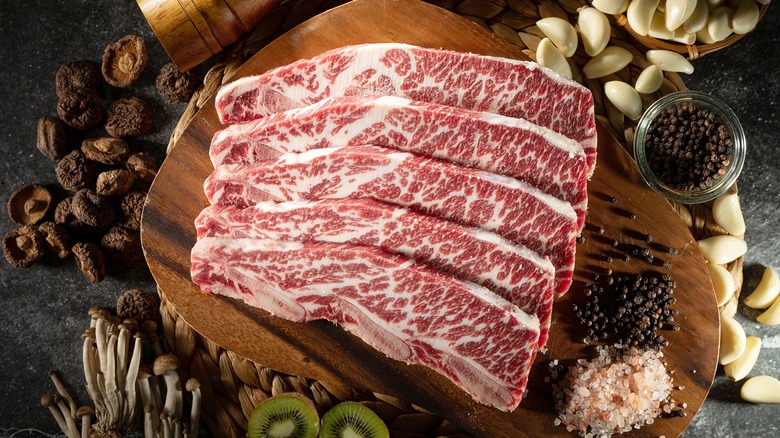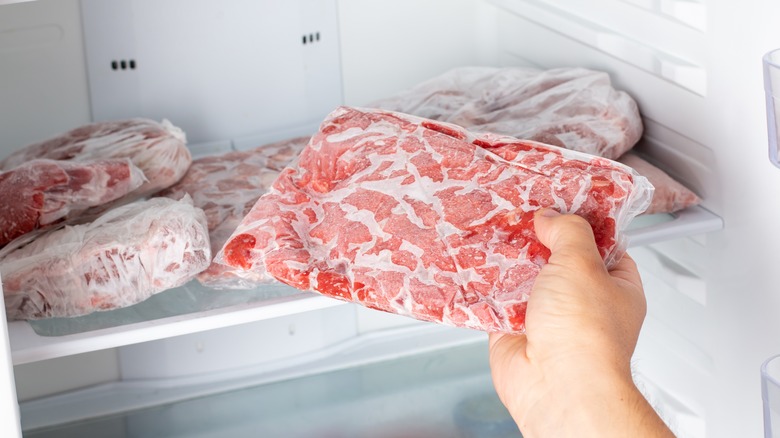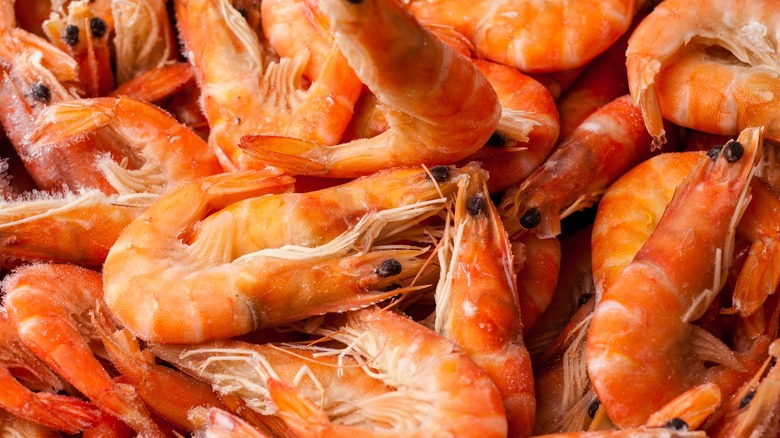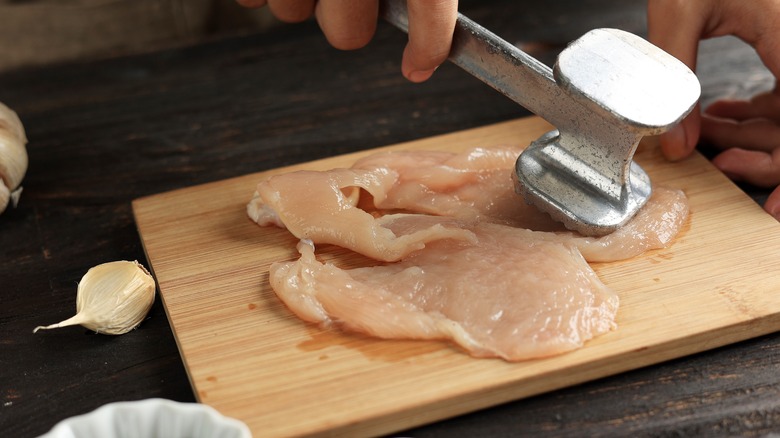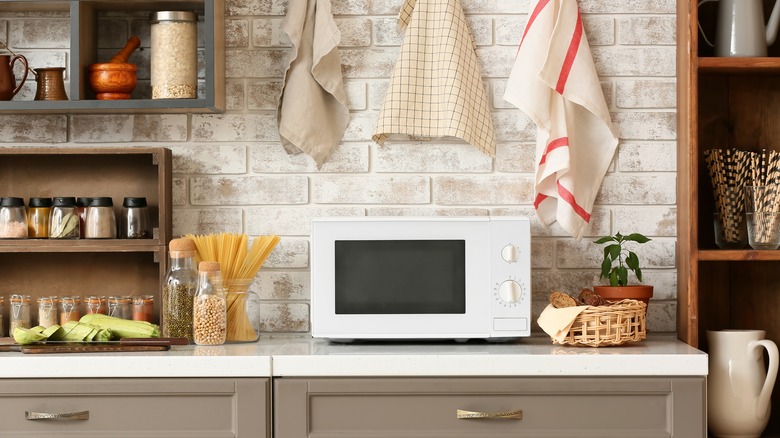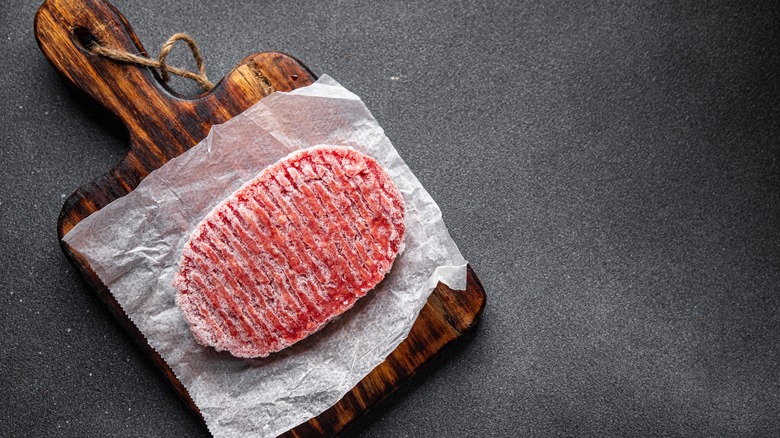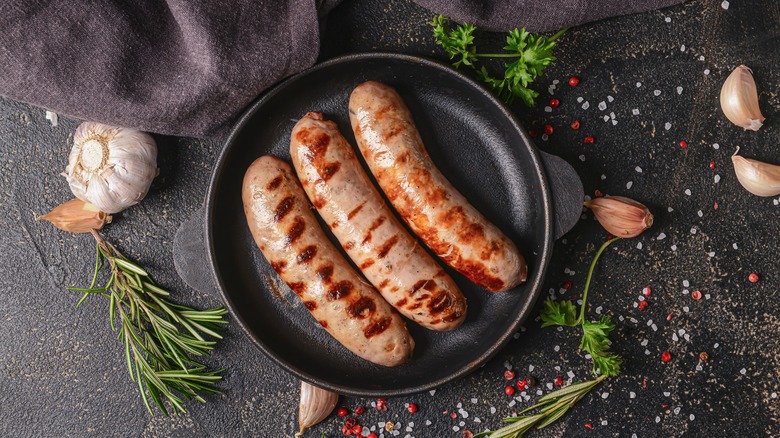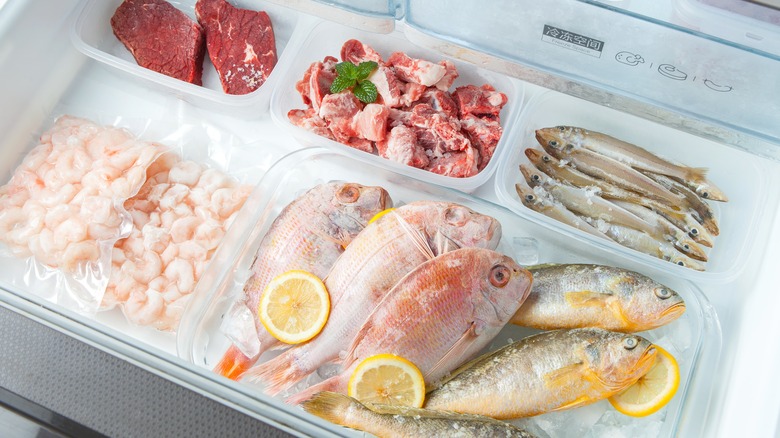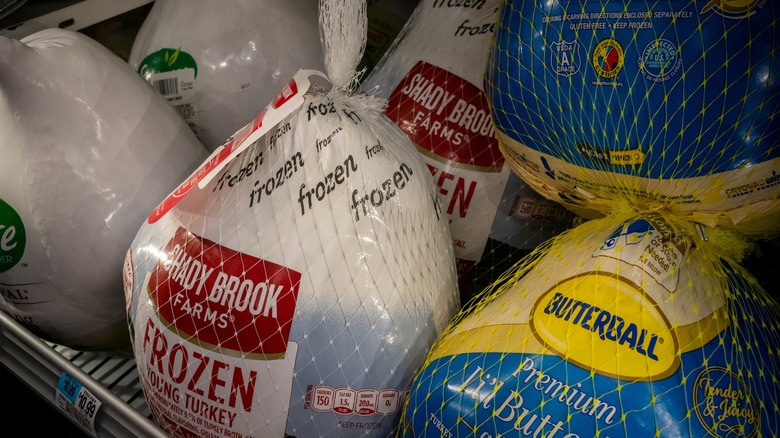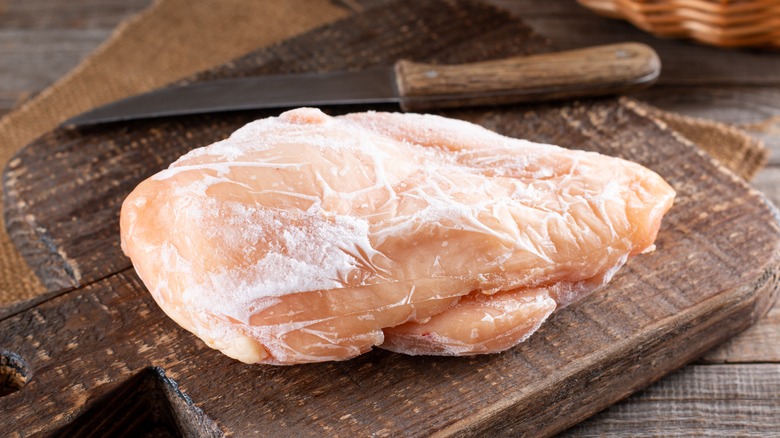10 Actually Reasonable Ways To Defrost Raw Meat
Defrosting meat is, at best, an irritating chore. But when you have just realized your guests are due in an hour and the steaks are still in the freezer, it can cause an outright panic.
The good news is that there are several actually reasonable ways to defrost raw meat, both when you have got wiggle room and when you're on a time crunch. Note that for the purposes of this guide, "meat" can also include seafood, although the directions may be different in that case. Take note of the specific instructions for each type of meat and defrosting method to ensure that you take the safest approach in every situation.
Also note that defrosting can happen quickly, even while simultaneously cooking. There are quite a few of these methods, so don't consign your meals to the garbage dump of dinnertime could-have-beens anymore. Instead, defrost them safely with these tips.
What does defrosting mean?
Although we all take the word defrosting for granted, what does it really mean? The answer is right there in the name, actually. To defrost is to remove the frost or ice from something, which is why we use the same word for thawing out a hunk of chicken as we do for clearing the buildup out of a freezer or ensuring wintertime windshield visibility.
And much as you want your windshield completely clear of frost, it's important to defrost food completely. That way, the entire piece of meat or seafood is the same consistency and temperature, with no frozen patches remaining. Otherwise, it might cook at different rates in different places, harboring dangerous bacteria.
According to the United Kingdom Food Standards Agency, you must defrost entirely unless the packaging specifically instructs you to cook from frozen or defrost for only a certain amount of time (such as with some pizzas). This will prevent frozen patches from lengthening the cooking time, which can also result in underdone parts of meat and seafood... which, just, yikes. Circling back to definitions, food is only defrosted if it is no part of it remains frozen.
Pro tips for defrosting safely
Whether you're thawing out fish, chicken, pork, lamb, beef, goat, or anything else, there are a few rules for what not to do. First of all, do not defrost in lukewarm water. This leaves your meat in the unsafe 40 to 140 F zone, which is where bacteria flourish. Nor is it safe when you leave it on the countertop. Although folks once believed this false fact, it's a good way to cause rapid bacterial growth. This is especially important for foods that you might cook rare, but it's best to follow across the board. That way you can cook to your desired level rather than, say, torching your pork chops in an effort to kill bacteria.
Equally important is that you understand it's a myth that freezing automatically kills all the bacteria on food (a fact this writer discovered when putting her COVID-riddled child's ice cream back in the freezer and wondering how long until it was safe to eat. The answer is pretty much never). Indeed, bacteria can remain for weeks or months, which means as soon as you pull out that pork chop or seabass, you have to worry about contamination of your kitchen surfaces.
To deal with this, make sure to contain your meat prep as much as possible in one area. Clean the countertops well before and after with soap, and don't fall prey to the myth that plastic cutting boards are more hygienic than wood.
1. Defrost in the refrigerator overnight
Any source seeking to provide the most accurate possible information (and not get sued) will tell you to defrost your meat or seafood overnight in the refrigerator, giving yourself 24 hours, if possible. Simply place it in a bowl or on a plate that will catch any juices.
Note that you shouldn't place meat on the top shelf of your freezer. As it defrosts, it releases liquid on the inside of the package that could drip down. Even if the plastic or butcher paper is watertight, there might be bacteria on the outside of it that could contaminate other items in the fridge when condensation forms and then runs off. Always choose a bottom shelf.
However, as anyone who has ever thrown an impromptu shindig, discovered an extra guest at dinner, or had children will tell you, this advice is frequently unhelpful. Sometimes a full day of lead time simply isn't in the cards. While the refrigeration method is good to know, that's only when followed by actually reasonable ways to defrost meat more speedily.
2. Start on the counter to speed up the fridge method
Remember, the danger zone is 40 to 140 F. If you keep your meat and seafood out of that range, you can safely use the countertop for a while before sticking your meat in the fridge. Just make sure to get it under refrigeration by the time it reaches 40 F, and always use a clean thermometer for checking the temperature. No, thank you cross-contamination.
This is a good way to speed meat along if you need to put it in a slow cooker that night or in the morning before work. Just make sure to transfer it before it reaches an unsafe temperature, otherwise you can't be sure it will cook to a high enough level in the Crock or Instant Pot. For the same reason (keeping your meat out of the bacterial growth zone), you always want to make sure to thaw your frozen meat completely.
3. Pound it out
You can speed up the defrosting method further by literally pounding it out. Take your ground beef or pork and put it between two pieces of parchment paper, then whack away with a meat mallet or rolling pin. This increases the surface area of the meat, offering more exposure for warming up. Since this method requires removing meat from the package, however, it's only suitable for fridge thawing the rest of the way. That doesn't mean you have to do the whole job in the fridge, though. It's a great hack for when your meat is almost defrosted but not quite there, a point you can safely reach using the cold water method. Then all you have to do is take it out of the package to finish the job.
Just make sure the final result is one you want to be bashed to smithereens. In other words, don't use it on your salmon or Wagyu beef. This approach is best for taco meat, sausage scrambles, and thin strips of chicken or steak headed for the wok. It's an especially effective strategy if you're going for patties anyway. And since ground meat spoils faster than whole cuts, it might be better to finish defrosting today than to defrost all the way and cook tomorrow.
4. Use the cold water method
With the cold water method, you put meat or seafood, still packaged, into a bowl of cold water. You can also fill the sink with water and use that. It's a pretty involved process, though, as you are supposed to change the water every time it warms up, so plan to switch it out several times depending on your climate and temperature. The United States Department of Agriculture (USDA) advises that you change the water every 30 minutes as a rule of thumb.
It should take about an hour for a 1-pound package, but you'll have to account for other factors, including the type of meat, depth of water, bowl placement, and so on. Some sources tell you to use cold running water, as though we all live near an alpine creek, but you can safely use frequent changes of tap water. While some sources claim that a bowl of very hot water will move meat through the danger zone rapidly and avoid bacterial growth, ignore this; the USDA says it's not safe.
5. Put the microwave to work
Unlike the so-called hot water method, which you should never use, the microwave does move meat through the bacterial danger zone fast. Therefore, you can safely use it to turn frozen cuts into ready-to-cook steaks and fillets in a matter of minutes. Unlike with the other methods above, you should remove the packaging right at the beginning of the process.
Start by setting your microwave's defrosting time according to the type and weight of your meat or seafood. This will help the microwave apply the proper amount of heat, de-icing the inside without turning the outside rubbery. While you need to budget some time for this (up to 15 minutes for a 12-ounce steak), that's a far cry from 24 hours in the fridge.
Make sure when defrosting meat in the microwave to use a dish that will catch all the juices. Bowls are ideal, as plates may not control all the liquid that comes off your meat. Rotate the meat or seafood if necessary to promote an even thaw. Lastly, cook it right when it comes out because it will almost certainly be in the bacterial danger zone.
6. Cook meat while still frozen
As you might imagine, a frozen cut of meat will cook more quickly on the outside than on the inside. Therefore, the main concern when cooking meat before you thaw it is getting it to a safe temperature. In the case of meat that you can eat rare, such as steak, this isn't a big issue... and in fact, most recipes recommend bringing the meat to room temp before cooking it. Not doing so (after safely thawing) is a common pan-seared steak mistake. Although the USDA does recommend 145 F with three minutes of rest time for steak, most people freely eat it rare at 130 to 135 F.
That said, you should never leave meat frozen on the inside. That's just gross and will usually mean the surrounding temperature is too low. Once you've got it thawed and warmed up, though, you're in business. For that reason, this is actually a good method for keeping steak rare while getting a good sear on the outside. Thin chicken cutlets, bacon, and anything ground are also a great option for this.
7. Put frozen sausages in a water bath
Have a package of frozen sausages? You can defrost them while cooking by submerging them in a water bath. This writer's parents were famous for huge, five-person-family-sized vats of sausages straight from the freezer. It's perfect on busy weeknights (preferably with a lifetime supply of sauerkraut and potato salad) and is a preparation method that has made it into this house as well. It's fast, easy, and requires no forethought... except to have sausages in the freezer. Always. Write that down.
As for methods, a wide pan is best for this, preferably stainless steel so you don't have to scrub rust off your cast iron afterward (although this won't kill your pan as long as you wash it right away after). Make sure to poke sausages so they release their liquid instead of exploding in the pan, which is kind of thrilling but not optimal safety-wise. Delightfully, the fat and juices will then caramelize on the outside of the meat for a nice sear once the water evaporates.
For the optimal sausage-cooking experience, put enough water in the pan to come about halfway up the frozen sausages. It's totally fine to crowd the pan; you'll just need to reduce the amount of water accordingly. Put the pan on medium to medium-high until the water cooks off, flipping the sausages halfway through the evaporation process. Then brown as desired, turning sausages to reach as many sides as possible.
8. Cook fish while still frozen
Yep, you can cook fish before it thaws as well, but not all varieties. Grilling and pan-searing aren't a good option for frozen fish, as a general rule, since the outside tends to fall apart before you get the insides all the way cooked. Fattier fish like salmon don't tend to do well using dry heat as with broiling, though if you give them a low-and-slow treatment (like poaching or baking), it will work.
In general, if you're going to cook from frozen, skip rich, thick, fatty species such as salmon, mackerel, and swordfish. Instead, opt for thinner and less juicy types, such as cod and tilapia. These both work fairly well when coated in oil and then pan-seared, and they are also quite good when breaded and put under the broiler. After all, this is how fish sticks work, and who doesn't love a good fish stick? No one, that's who.
If you really want to use a fatty species of fish and can't wait to defrost, then poach or steam your fish. You'll just want to add a few minutes to whatever your recipe calls for to make sure the fish is cooked all the way through. Simply remove a piece from the water or steamer basket to test. Another strategy for using oily fish, such as salmon, is to put it in a curry. There, the liquid it releases won't be an issue at all; it's a flavorful benefit.
9. Defrost a turkey one of two ways
The most notoriously difficult culinary item that needs defrosting? A turkey. Anyone who has ever cooked one knows the paralyzing feeling of trying to balance competing factors: having the turkey defrosted in time to cook, but not so far in advance that you have to find room in the fridge for it. Because let's be honest, there's no such thing as room in the fridge during the holidays.
While you can buy turkeys fresh and never frozen, they are so ungodly expensive you'd assume each one was personally hugged by a Kardashian before being sent to market. Even some of the "Make sure you reserve an organic, free-range, grass-fed turkey in time for the holiday!" options are frozen, so don't assume otherwise.
If you do get a frozen turkey, there are two main defrosting choices: cold-water thawing and fridge defrosting (note that these tips generally apply to ham, as well). In your somehow roomy refrigerator, place the turkey breast up on a tray while still in its wrapper. For every 4 pounds of meat, budget a day of thawing time. Once thawed, use within four days. To thaw in water, use a tub or sink and cover the bird with cold water, changing the water every half hour and rotating the turkey regularly if it is not completely submerged. This method, while higher-maintenance, only takes about 30 minutes per pound, perfect for any brave soul who makes last-minute turkey plans.
10. Take special care with chicken
Chicken is easily the meat most likely to have you praying to the porcelain god. During preparation at slaughterhouses, it often gets dipped in hot water, which gives bacteria ample time to grow in the danger zone. Plus, its skin has dimples and pockets that can trap pathogens. When defrosting chicken, therefore, you have to be extra careful. Yes, a mild, safety-oriented, poultry-related phobia is better than winding up with food poisoning.
If you're going to defrost chicken any way other than using the 24-hour refrigerator method, make sure it's defrosted completely. Otherwise, you could test for doneness in one area and get a good result, while leaving another area underdone. The best way to be sure is to use chicken that doesn't have bones so you can't mistake a frozen patch for them. If your chicken does have bones, you probably want to use refrigeration just to be safe.
The microwave method is probably the second safest for chickens. Have everything else prepped ahead of time so you can oil and season the meat, then pop it into the pan or oven right away when it emerges from the microwave. Use a meat thermometer when checking to ensure that it is evenly done. Don't just poke it in the thigh and look for clear juices; it's a myth that this means all the pathogens have been killed. Temp is the only safe method for testing poultry, so get a good thermometer and use it.
Always cook meat the same day
Since you've gone to all that work defrosting your meat, one assumes you would want to cook it right away. However, sometimes life gets away from you, so it's important to note that you really do need to cook it the same day in many cases. Once you defrost meat, it no longer has the months-long shelf life it had in the freezer. For instance, steaks do well in the freezer for nine to 12 months, while ground beef is good for up to four months.
If you defrosted under refrigeration, you can go ahead and wait a few days. However, if you used a heat-based method, such as microwaving, it's time to cook stat. Cold water baths are, while safe, typically warmer than the 40 F called for under refrigeration, so don't wait on that method, either.
There is one item of good news on this front, which is that "If raw foods such as meat, poultry, egg products, and seafood have been thawed in the refrigerator, then they may be safely re-frozen for later use," according to the Washington State Department of Health. However, advises the site, that if foods were thawed outside the fridge (in cold water or the microwave), you must cook them all the way and right away.
